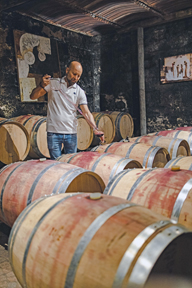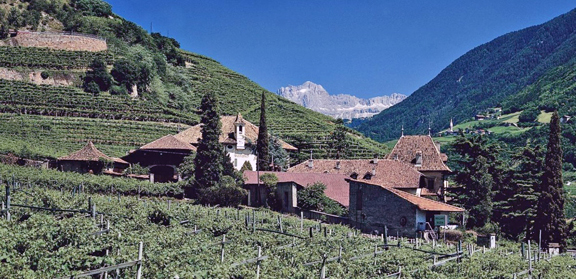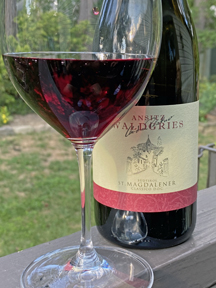Ansitz Waldgries
(An Online Virtual Visit)
by
Kathy and Terry Sullivan
Photos provided by
Ansitz Waldgries unless otherwise noted.
This article about Ansitz Waldgries is based on an online interview, online data and photos supplied by the winery. The winery graciously sent a sample of wine. The article was written during the time of the worldwide 2020-2021 pandemic. Christian Plattner at Ansitz Waldgries responded to our questions.
 Summary: Ansitz Waldgries, located in South Tyrol, offers a long wine/vineyard history, dating back to the 1200s. The vineyards are in the well-known St. Magdalena region. Ansitz Waldgries is open to the public for wine tastings Monday through Saturday. The current owner is Christian Plattner (image right provided by Zulu Pictures via Ansitz Waldgries)
Summary: Ansitz Waldgries, located in South Tyrol, offers a long wine/vineyard history, dating back to the 1200s. The vineyards are in the well-known St. Magdalena region. Ansitz Waldgries is open to the public for wine tastings Monday through Saturday. The current owner is Christian Plattner (image right provided by Zulu Pictures via Ansitz Waldgries)
History
Documentation indicates that Ansitz Waldgries existed as early as 1242 with the first owner, Roblinus de' Waldgries. After 14 owners, Christian’s grandfather purchased the property in 1937. Christian’s grandfather had been in search of a winery and chose to purchase Ansitz Waldgries in the St. Magdalena region.
Christian Plattner, “The wine ‘St. Magdalener’ was at that time almost entirely sold as open wine to Switzerland and therefore not available in the homeland. But since the demand was also high in South Tyrol, he was the first to decide to bottle the wine. In 1970, Christian's father, Heinrich Plattner, was one of the first to start bottling. "The incisive moment was the 'birth’ of the wine S. Maddalena Classico Antheos' in the year 2010, because this wine goes back to the origins; as in the past, it unites eight historical Schiava varieties."
The importance of Santa Magdalena was noted by Christian, “We have investigated and started experiments - in viticulture as well as in the cellar. Always with the aim of reviving this original St. Magdalener and presenting it in a new way. This is not only out of pure curiosity. We do not want to let this winemaking tradition and history be forgotten. And we would like to better understand the wines of our time and how they relate to the wines of the past. The result is presented in the bottle: a piece of history and a piece of the future united, in St. Magdalener Classico Antheos.”
Christian was fascinated with wine and winemaking at an early age and followed this interest into a long life of producing wine.
Vineyards
The vineyards consist of 7.2 hectares (18 acres). Grape varieties found in the vineyards include Schiava, Lagrein, Omscato Rosa, Sauvignon Blanc and Pinot Blanc.

Indigenous grape varieties occupy 80% of the vineyards. Wine Trail Traveler asked, “What is the public’s perception of wines made with indigenous grapes?”
Christian replied, “Very good; the trend goes more and more to the autochthonous grape varieties, or grape varieties adapted to the terroir. Our guests are interested in the connection with history and tradition, and wine lovers like to drink wines that tell a story and match the terroir.”
Winemaking
During the winemaking process, it is important for Christian Plattner to constantly taste the new vintages including after fermentation, after the malolactic fermentation and during aging.
For the future, Christian wants to continue to increase the quality of the wines rather than increasing the wine production.
Wine
 We were sent a sample of the 2020 St. Magdalener Classico, a blend of mostly Schiava with a splash of Lagrein (pictured right by Wine Trail Traveler). The grapes for this wine were harvested from a 2.6 hectares (6.4 acres) plot at 350 meters (1148) above sea level in the St. Magdalener Cru. The wine was fermented in stainless steel and then aged for five months in large oak cask. The 13% alcohol wine had a dark ruby color with a dark pink hue. The aroma was reminiscent of a berry fruit salad. The taste offered several fruits including blueberries, blackberries, black cherries, and black and red raspberries. The wine had a medium/full body with medium tannins. The fruity finish yielded to spices. We paired the wine with a ziti pizza.
We were sent a sample of the 2020 St. Magdalener Classico, a blend of mostly Schiava with a splash of Lagrein (pictured right by Wine Trail Traveler). The grapes for this wine were harvested from a 2.6 hectares (6.4 acres) plot at 350 meters (1148) above sea level in the St. Magdalener Cru. The wine was fermented in stainless steel and then aged for five months in large oak cask. The 13% alcohol wine had a dark ruby color with a dark pink hue. The aroma was reminiscent of a berry fruit salad. The taste offered several fruits including blueberries, blackberries, black cherries, and black and red raspberries. The wine had a medium/full body with medium tannins. The fruity finish yielded to spices. We paired the wine with a ziti pizza.
Wine Tourism
Ansitz Waldgries has a 600m (1969 feet) “wine path” for visitors to enjoy. Christian wrote, “Along the old street on Renon, in the middle of the vineyards, the wine path was designed by the South Tyrolean artist Philipp Moroder Doss. Visitors learn about locations, climate, vineyard work, cultivation, culture and much more. This path leads to a vantage point from which one has a wonderful view of the city of Bolzano with S. Maddalena, Rencio and the castles of Campegno and Cornedo.”
Information at the winery is available in German, Italian and English.
Food and Wine
Christian suggested the following food pairings for six of the Ansitz Waldgries’ wines.
• Sauvignon Blanc: Fish, vegetarian dishes, light meats, asparagus
• Pinot Blanc: Grilled fish, light meats, flavorful pasta dishes
• Santa Maddalena Classico: Cold starters, smoked bacon, ham, sausage, Italian starter
• Santa Maddalena Classico Antheos: Mediterranean starters, main dishes - lamb and game birds
• Lagrein: Dark meat, braised and roasted, game (venison), strong cheeses
• Moscato Rosa: Chocolate mousse, gingerbread, sweets with bitter chocolate and cinnamon, nut and almond pastries, foie gras
When in Italy’s South Tyrol region, consider a visit to a historic winery, taste the wines and walk the 600m “wine path.”
Ansitz Waldgries Wine Estate
S. Giustina 2, I-39100
Bolzano
South Tyrol – Italy
Article written September 2021.
Visit these tour operators that partner with Wine Trail Traveler.
 |
||||
|
Spain and Portugal |
SmoothRed London, England, United Kingdom |
